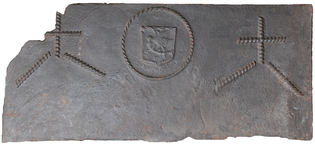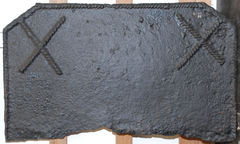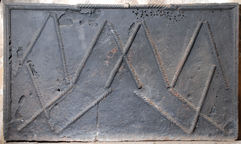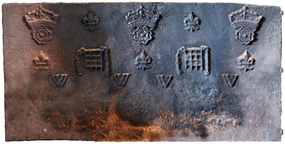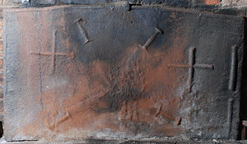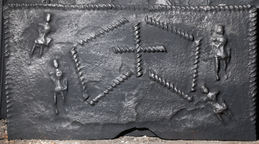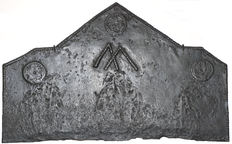-
435
Description: Rectangular (damaged top left corner); plain plate; centre top, a circle of twisted rope enclosing a shield, indented at the top, charged with a bird upon a branch; on each side, a cross of twisted rope above two splayed lengths of rope.
Notes: The rope design is likely to be apotropaic; the heavily pitted reverse of this fireback shows the use of poor quality iron cast at a relatively low temperature; the bird shield stamp has been seen on other firebacks.
- Decoration tags:
- rectangular (shape)
- none (edging)
- simple stamps
- carved stamps
- apotropaic
- armorial
- objects
Manufactured: in the early- to mid-16th century in the Weald area of England.
Current location: Anne of Cleves House, Southover High Street, Lewes, East Sussex, England.
(part of the Sussex Archaeological Society museum group)
- Attached to series:
- Bird shield series
- Rope design firebacks
-
441
Description: Sub-rectangular; edged with a repeated length of helically-turned dowel (top and sides); apparently random arrangement of same piece of dowel repeated ten times, including a saltire and cross.
Notes: Apart from the Christian significance of the cross, the other arrangements of rope lengths may be apotropaic in their purpose, the double V being a possible invocation of the Virgin. The blemishes at the base are caused by the casting sand being disturbed by the pouring of the metal.
- Decoration tags:
- rectangular (shape)
- rope (edging)
- simple stamps
- apotropaic
- objects
Manufactured: in the 16th century in the Weald area of England.
Current location: Anne of Cleves House, Southover High Street, Lewes, East Sussex, England.
Museum number: LH000.799 (part of the Sussex Archaeological Society museum group)
Citation: Dawson, C., 1903, 'Sussex Iron Work and Pottery', Sussex Archaeological Collections, 46, pp. 1-54.
Citation: Gardner, J. S., 1898, 'Iron Casting in the Weald', Archaeologia, 56, 1, pp. 133-164.
- Attached to series:
- Rope design firebacks
-
455
Description: Canted rectangle; twisted rope edging (top and sides); a rope saltire in each top corner.
Notes: The edging is made from the same, short lengths of rope as the saltires.
- Decoration tags:
- rectangular with canted top corners (shape)
- rope (edging)
- simple stamps
- apotropaic
- objects
Manufactured: in the 16th century in the Weald area of England.
Current location: Hall Place, Bexley, Kent, England.
Museum number: 1944.24.049 (part of the Sussex Archaeological Society museum group)
- Attached to series:
- Rope design firebacks
-
485
Description: Rectangular; ovolo moulded edging (top and sides), except for middle section on top, where twisted rope is used; quasi-symmetrical arrangement of twisted rope lengths in two rows of alternate diagonals, crossing in the middle on the top row, and crossing on the outside on the bottom.
Notes: The section of rope edging on the top suggests that an arch had been removed from the base pattern board. The arrangement of rope lengths may have apotropaic significance, the double 'v' alluding to the Virgin Mary.
- Decoration tags:
- rectangular (shape)
- ovolo (edging)
- simple stamps
- apotropaic
- objects
Manufactured: in the mid- to late-16th century in the Weald area of England.
Current location: in private hands, Mayfield, East Sussex, England.
- Attached to series:
- Rope design firebacks
-
1222
Description: Rectangular shape; no edging; symmetrical arrangement of four stamps: across the top, three crowned roses with a fleur-de-lys between each pair; across the middle, three fleurs-de-lys with a chained portcullis between each pair; below and in the spaces between the fleurs and portcullises, four letters W.
Notes: The letter W may have an apotropaic significance; the stamps have not been recorded on other firebacks.
Inscription: W W W W
- Decoration tags:
- rectangular (shape)
- none (edging)
- carved stamps
- heraldic
- apotropaic
- text
- objects
Manufactured: in the late-16th century possibly in the Weald area of England.
Current location: Great Dixter, Northiam, East Sussex, England.
- Attached to series:
- Miscellaneous royal firebacks
-
587
Description: Quasi-rectangular; grooved dowel edging (top and sides); four impressions of a rondel dagger (c.330mm) saltirewise between two dowel crosses; two vertical lengths of dowel in line along right edge.
Notes: Rondel daggers were common in the 15th and 16th century. Grooved lengths of dowel are to be seen on other firebacks suggesting a common source. The arrangement of the daggers (each approx. 35cm long) in a saltire may also have apotropaic significance.
- Decoration tags:
- rectangular (shape)
- grooved dowel (edging)
- simple stamps
- apotropaic
- objects
Manufactured: in the mid-16th century in the Weald area of England.
Current location: in private hands, Plaxtol, Kent, England.
- Attached to series:
- Grooved dowel series
- Knife & Dagger stamp firebacks
-
628
Description: Rectangular; twisted rope edging (top and sides); twisted rope length stamped eight times in a mirrored double rhombus pattern with a central cross; a crude human figurine stamped irregularly four times, two on each side of the rope design.
Notes: An uncharacteristically small fireback for its likely period.
- Decoration tags:
- rectangular (shape)
- rope (edging)
- simple stamps
- carved stamps
- apotropaic
- objects
Manufactured: in the mid- to late-16th century possibly in the Weald area of England.
Current location: Mark Ripley Forge & Fireplaces, Northbridge Street, Robertsbridge, East Sussex, England.
- Attached to series:
- Miscellaneous stamp firebacks
- Figurine firebacks
- Rope design firebacks
-
733
Description: Rectangular with canted top corners and a triangular extension from the top edge; twisted rope edges to all sides except bottom; a circular wafering iron or butter mould stamp, incorporating a square design with a fleur-de-lys on each side, repeated thrice, one at the apex and one below each of the canted corners; two inverted ‘V’ rope shapes overlapping to make an ‘M’ below top stamp.
Notes: The inverted double 'V' may be apotropaic, invoking the protection of the Virgin Mary; the circular stamp has also been noted on a Pelham-associated fireback of 1642 (no. 1204) which may suggest that it was a product of one of the family's ironworks.
- Decoration tags:
- rectangular with triangular arch (shape)
- rope (edging)
- simple stamps
- apotropaic
- objects
Manufactured: in the late-16th to early-17th century possibly at Waldron Furnace in the Weald area of England.
Current location: Victoria & Albert Museum, Cromwell Road, Kensington & Chelsea, Greater London, England.
Museum number: 895.1901 (part of the Victoria & Albert Museum museum group)
Citation: Page, S. & Wallace, M. (eds.), 2018, Spellbound (Oxford, Ashmolean Museum), p. 72.
- Attached to series:
- Food mould stamp firebacks
- Rope design firebacks
